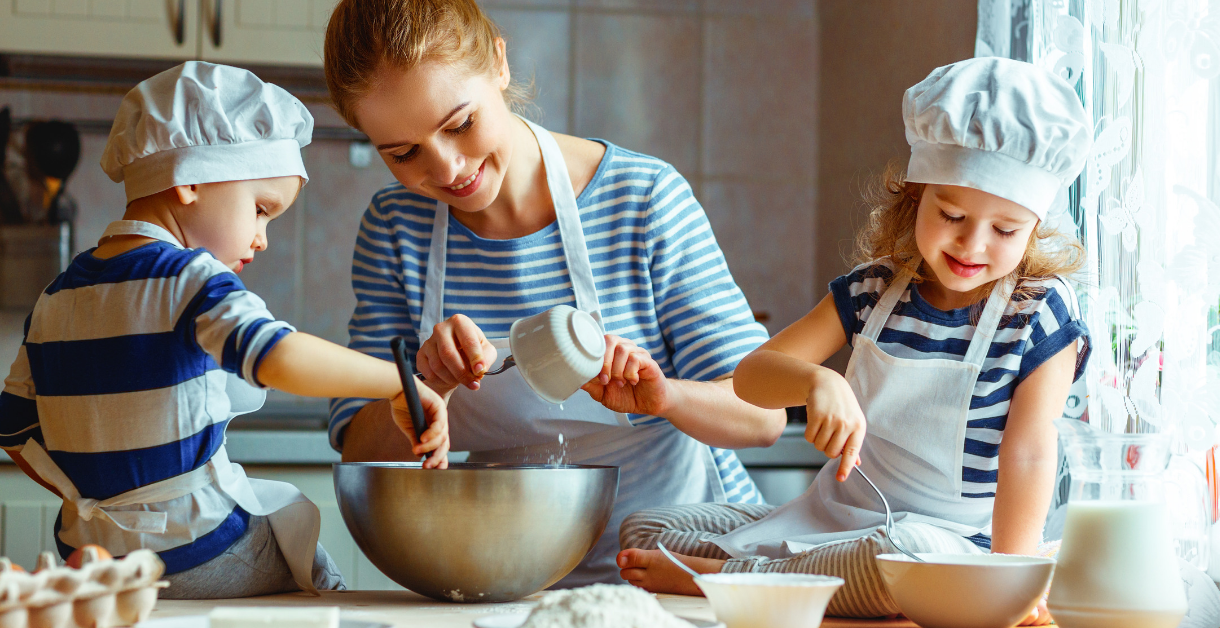The great thing about science is that it is so much more fun with hands-on activities! Enjoy these simple “edible” experiments with common ingredients found in your kitchen.
Let’s Make Some Bread!
Homemade rolls are not only yummy but there’s nothing like that fresh bread smell in your kitchen in the morning.
All you need is:
• Sugar
• Salt
• Cup Warm Water
• 1 Package Yeast
• Milk
• Butter
• 4 Cups of Flour
• Measuring Cup & Measuring Spoon
• Large and Small Mixing Bowls
Steps:
- In a small mixing bowl, dissolve a package of yeast in 1/2 cup of lukewarm water.
- Add 1 teaspoon of sugar and let it sit for 5 minutes.
- In a saucepan, melt 1 1/2 teaspoons of butter.
- Add 3/4 cup of milk to the butter and heat until the mixture is warm.
- Add the butter/milk mixture to the yeast.
- Add 1/8 cup of sugar and 1 teaspoon of salt to the mixture and mix.
- Add flour to mixture 1 cup at a time (about 2 1/2 to 3 cups total).
- Put the dough on a lightly floured surface and knead for 10 minutes (until it is smooth and elastic).
- Now, place the dough in a buttered bowl, cover with a warm damp cloth, and let it rise until it has doubled in size (about 1 to 1 1/2 hours).
- Once the dough has risen, you can make the rolls.
- Place the rolls on a cookie sheet, cover with a warm damp cloth, and let them rise until they have doubled in size.
- Preheat the oven to 350°F.
- Bake the rolls for about 20-25 minutes (until the bread sounds hollow when you tap it).
Science Connection: How do the rolls get fluffy? Yeast gets activated in the warm water with the sugar. The yeast metabolizes the sugar in the bread and produces carbon dioxide. The carbon dioxide rises but cannot escape the dough and so the bread becomes fluffy.
Shake, Shake, Shake and Make Butter
Ready to serve the bread you made above but out of butter? No problem. This easy experiment can create butter in a few minutes plus you can get some exercise in with all the shaking needed to make this work.
All you need is:
• Small Jar with Lid
• Heavy Whipping Cream
• Measuring Cup & Measuring Spoon
Steps:
- Add 2 tablespoons of whipping cream to the small jar.
- Cover your jar and start shaking (the harder the better).
- After a couple of minutes, open the jar and look at what is happening inside. Does it look like whipped cream?
- Close the jar again and keep shaking (very hard!) until you have a little bit of liquid and a ball of butter.
Science Connection: Really, shaking can make butter? By shaking the whipping cream, the fat in the cream and protein particles stick together to form a butter ball. The liquid formed at the end is buttermilk (also known as a byproduct).
Make Ice Cream in a Bag
Cool down this summer by making ice cream in a bag. Ready to try?
All you need is:
• Milk
• Heavy Whipping Cream
• Sugar
• Vanilla
• Salt
• Ice
• Large Ziploc® Bag (any brand will do)
• Small Ziploc® Bag (any brand will do)
• Measuring Cup & Measuring Spoon
Steps:
- Add 2 tablespoons of sugar, 4 tablespoons of milk, 4 tablespoons of whipping cream, and 2 tablespoons of vanilla to the small bag. Then seal the bag.
- Add 2 cups of ice and 6 tablespoons of salt to the large Ziploc bag.
- Place the small bag with ingredients into the large bag of ice and salt and seal the bag securely. Then gently rock the large bag from side to side (you might want to wear some gloves or hold the bag on top where it is not as cold!)
- Once your ingredients have turned into ice cream (about 10-15 minutes), open the bags and enjoy the ice cream in the small bag!
Science Connection: This experiment shows how adding salt to the ice makes the freezing point of the ice lower than is needed for ice cream to form. The inner bag with the ingredients gives off heat as it is warmer than the surrounding ice. This heat makes the surrounding ice melt, and at the same time, the whipping cream mixture gets cold enough so that ice cream forms.
![]() Esther Novis is a mom to now 5 grown children with one still in high school, and the founder and President of The Young Scientists Club. She started The Young Scientists Club in 1999 looking for activities for her children and as a way to put her science degrees from Harvard University to good use.
Esther Novis is a mom to now 5 grown children with one still in high school, and the founder and President of The Young Scientists Club. She started The Young Scientists Club in 1999 looking for activities for her children and as a way to put her science degrees from Harvard University to good use.


